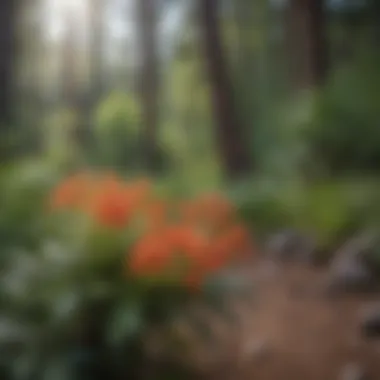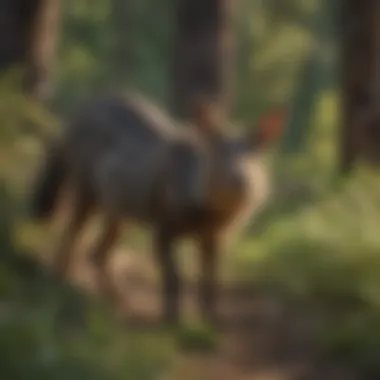Hiking Trails and Natural Wonders in Missoula


Intro
Missoula, Montana, shines as a hidden gem for hiking aficionados and nature lovers alike. Nestled among the picturesque Rocky Mountains, this city not only boasts stunning landscapes but also a variety of trails that speak to different skills and interests. From the bald peaks boasting panoramic views to the verdant valleys teeming with life, the hiking experience in Missoula is diverse.
The trails around this area are rich in both history and ecological significance. As you lace up your boots, you're stepping into a living classroom, full of flora and fauna unique to this region. Whether you're a seasoned hiker or merely dipping your toes into the world of outdoor adventures, preparation is crucial.
In this article, we will delve into the remarkable hiking opportunities in and around Missoula. We'll explore the trails, understand the ecological essence of this space, and offer practical guidance for those embarking on these adventures. It's imperative that we engage with the local environment responsibly, ensuring we protect the natural wonders for generations to come.
Overview of Missoula Hiking
Hiking in Missoula isn't merely an outdoor activity; it's an immersion into a tapestry of picturesque landscapes woven with rich ecological and cultural threads. Missoula's location, nestled among the rugged mountains and sweeping valleys of Montana, offers an array of trails that entice hikers of all skill levels. The significance of exploring this area extends beyond physical exercise; it's about connecting with nature and gaining insight into the ecological systems that thrive there.
Geographical Context
Missoula is located in the northern Rockies, geographically blessed with an impressive variety of terrains. Its proximity to the Bitterroot Mountains and the Lolo National Forest means that hikers can experience everything from easy strolls along riverbanks to challenging climbs up steep slopes. Notably, the city sits at the confluence of the Clark Fork and Bitterroot Rivers, which further enhance the region's natural beauty.
The trails radiate from Missoula, creating a network that beckons enthusiasts to explore. Each path offers distinct scenery, from dense forests rich with quaking aspens to sun-drenched ridges where one can view the sprawling valleys below. This geographical diversity not only makes hiking in Missoula visually stimulating but also ecologically rich, as various micro-environments support different species of plants and animals.
Climate Considerations
Weather in Missoula plays a crucial role in hiking planning. The climate features a mix of warm summers that encourage outdoor activity and cold winters that blanket the area in snow.
During the summer months, average temperatures hover around the mid-seventies Fahrenheit, perfect for long hikes without an overbearing heat. However, it’s essential to be aware of the occasional thunderstorm that can roll in, often with little warning. On the other side of the calendar, winters can be tough – lows in the twenties Fahrenheit mean snow-covered trails are common, but this also opens up opportunities for snowshoeing and winter hikes if one is equipped properly.
Hikers should always consult weather forecasts and prepare for rapid changes in climate. Carrying layers and being mindful of storm patterns is a must for anyone seeking an adventure on the trails around Missoula.
Cultural Significance
Hiking in Missoula is not just about traversing through nature; it’s intertwined with the history and culture of the area. Missoula has a rich indigenous heritage, and many trails present opportunities to learn about the traditions and values of the Salish and Pend d’Oreille tribes that have lived in this region for centuries. Stories of the land, along with its flora and fauna, are kept alive through the hiking community and local events.
Moreover, hiking fosters a sense of community and belonging among residents and visitors. Groups often gather for hikes, sharing experiences that deepen their appreciation for both nature and each other. Trails become a meeting point where newcomers and locals exchange stories, making each hike a unique social experience as well.
"Hiking connects us to the land, but it also connects us to one another. It's not just about the destination, but those we meet along the way."
By understanding the geographical, climatic, and cultural contexts of Missoula hiking, enthusiasts can prepare for a fulfilling experience that is as enriching as it is adventurous.
Notable Trails in Missoula
In the context of Missoula, the trails represent not just pathways through landscapes but corridors connecting both history and ecology. Hiking these notable trails offers experiences rife with discovery, whether it’s a glimpse of rare flora, an encounter with native wildlife, or simply the joy of breathing fresh mountain air. They stand as essential elements in the tapestry of outdoor recreation that enriches the community's culture and environmental understanding.
Rattlesnake National Recreation Area
The Rattlesnake National Recreation Area is a hidden gem in Missoula, offering over 48 miles of trails that wind through lush forests and scenic vistas. This area isn't just another set of paths; it’s a sanctuary for outdoor lovers. As you meander through, you're likely to encounter old-growth forests filled with towering ponderosa pines, ripe with character.
The sound of the Rattlesnake Creek, alive with the rush of water, complements the serenity of the surroundings. Visitors often hike to the stunning Rattlesnake Lake, where the reflection of the mountains creates a picturesque scene, ideal for photography enthusiasts. The trails here cater to various skill levels, making it a preferred destination for families as well as seasoned hikers.
"Hiking in Rattlesnake offers not just adventure, but an intimate connection with the majesty of nature."
Mount Sentinel
Mount Sentinel, famed for its iconic ‘M’, provides a challenging yet rewarding experience. Standing guard over Missoula, this trail rewards hikers with panoramic views of the city below and the sweeping landscapes beyond. The climb, though steep, is short enough to encourage many to test their limits.
As you ascend, you'll discover diverse ecosystems, from rocky outcrops to patches of wildflowers. Summer particularly flourishes here, with blooming penstemons and bitterroots completing the vibrant palette. Each visit to Mount Sentinel feels unique, shaped by seasonal changes that shift the wildlife and plants in surprising ways. The view from the summit, especially during sunset, is an experience that sticks with you long after the hike is over.
Blue Mountain Trail


Moving south of the city, the Blue Mountain Trail offers something a bit different. This trail is part of the larger Blue Mountain Recreation Area and is ideal for those seeking a blend of solitude and natural beauty. It stretches over 6 miles, frequently covered in aromatic pine and oak. Despite its accessibility, the trail often feels isolated, providing a perfect escape from the hustle and bustle of everyday life.
You might spot deer or even a majestic elk grazing along the verdant edges of the path if you have a keen eye. As the trail elevates, the horizon expands to capture the grandeur of the Bitterroot Mountains. Most notable is the rewarding experience of silence; it's the kind of peace that resonates deeply with those who wander here.
Lolo National Forest Paths
If you’re looking for a deeper dive into wilderness, the paths of Lolo National Forest are a must-visit. This expansive area offers thousands of miles of forest trails, where you'll find remnants of the area's rich history, both geologically and culturally. The forest’s varied terrain presents unique challenges and delights for hikers; traversing alongside the mountains’ foot or skirt the edges of pristine lakes feels like stepping into a natural cathedral.
Wildlife thrives here, too. With careful observation, you have a good chance of spotting elusive creatures like mountain goats or even black bears. The combination of towering trees, flowing streams, and the faint sounds of nature creates a harmonious backdrop that can feel both awe-inspiring and humbling. These trails not only provide pathways through nature but also through time, echoing stories of the lands and their inhabitants.
Exploring these trails is more than just physical effort; it nurtures an understanding of the natural world. Each hike through these scenic locales connects you further to the land, reinforcing the importance of responsible engagement with these magnificent landscapes.
Ecological Aspects of Hiking
Understanding the ecological aspects of hiking is essential for a deeper appreciation of Missoula's stunning landscapes, and for ensuring their preservation for future generations. This section delves into the vital interplay between hiking activity and ecology, emphasizing local flora, fauna, and conservation efforts that safeguard these natural environments. Hiking isn't just a pastime; it's an engagement with the intricate web of life that surrounds us.
Flora Along the Trails
The trails around Missoula are vibrant tapestries of diverse plant life. Each species tells a story, showcasing the region's unique biodiversity. Dominant species such as ponderosa pine, western larch, and Douglas fir can be found soaring skyward, creating a canopy that supports a myriad of understory plants, including wildflowers and berries.
- Some notable plant species are:
- Bitterroot: A state flower of Montana, known for its beautiful pink blossoms.
- Saskatoon Berry: Not just for the birds, hikers too can enjoy its sweet fruit.
- Lodgepole Pine: Plays a crucial role in maintaining the health of local forests.
These plants not only offer aesthetic beauty but also play key roles in their ecosystems. They provide habitats for various animals and form necessary parts of local food chains. Moreover, certain flora acts as indicators of ecological health. Observing their presence and vigor can often signal the well-being of the entire ecosystem.
Fauna and Wildlife Encounters
Hiking in Missoula opens the door to numerous wildlife encounters. From the majestic elk to the elusive black bear, this area is rich in fauna that plays critical roles in the ecological landscape. Encountering wildlife, while exhilarating, necessitates respect and responsibility from hikers.
- Common animals you might see include:
- Deer: Often at the edge of trails, these graceful creatures are common sights.
- Birds: Varieties such as eagles, owls, and various songbirds populate the area, adding to the natural symphony.
- Small Mammals: Squirrels and foxes dart about, crucial for ecological balance.
"Each step along the trail is a chance to connect with the wild inhabitants. Yet, tread carefully; their home is at stake."
The need for awareness regarding seasonal behaviors, breeding times, and migration patterns becomes paramount. Respecting wildlife is a shared responsibility of every hiker, ensuring that encounters remain safe and sustainable.
Conservation Efforts in Hiking Areas
With the beauty of Missoula's hiking trails comes the responsibility to protect these natural gems. Many organizations and community groups work tirelessly to promote ecological health and sustainable hiking practices. Conservation efforts include:
- Trail Maintenance: Regular upkeep ensures trails remain safe and minimize ecological damage.
- Invasive Species Removal: Non-native plants pose a significant threat to local ecosystems. Volunteers often participate in removal projects to maintain biodiversity.
- Public Education: Workshops and materials aimed at hikers inform the public about responsible hiking practices and the importance of ecosystem preservation.
The synergy of community involvement and ecological awareness is crucial. Local initiatives not only engage the public but also enhance the natural beauty and health of hiking environments. Each step taken with respect for nature contributes to the broader goal of conservation, ensuring these trails will be there for future adventurers.
Preparing for Your Hiking Experience
When it comes to hiking in Missoula, preparation isn't just a good idea—it's essential. Nestled between the Rocky Mountains and the vibrant culture of the city, the trails here offer a mix of breathtaking views and diverse ecosystems. Yet, the joy of hiking can quickly turn to discomfort or danger without the right groundwork. Understanding what you need to pack, how to navigate the trails safely, and keeping your physical condition in check can make or break your hiking adventure.
Taking the time to prepare can enhance your experience manifold. Proper equipment ensures safety against the unpredictable nature, while an awareness of physical fitness can prevent injuries and ensure enjoyment. Above all, good preparation sets the stage for a memorable connection with nature.
Essential Gear and Equipment
Packing the right gear is crucial. Think of your equipment as your lifeline during your hike. Here’s a breakdown of the essentials:
- Footwear: Don't underestimate the importance of sturdy hiking boots. They should fit well, provide good support, and be suited for the trail conditions.
- Clothing: Layers are your friend. Summers can be warm, but mornings might still be chilly, so pack moisture-wicking, breathable fabrics and consider a light jacket.
- Backpack: Choose one that’s comfortable to carry and large enough for your gear without being cumbersome. A good daypack should ideally include compartments for organization.
- Navigation tools: Whether a map, compass, or GPS device, having reliable navigation tools is key. Technology can fail, so it’s smart to have a backup.
- Hydration and snacks: Water bottles or hydration packs should never be neglected. Coupled with high-energy snacks, they keep you going on longer treks.
- First-aid kit: Accidents can happen, so having a first-aid kit on hand can provide peace of mind. Include the basics such as band-aids, antiseptic wipes, and any personal medications you might need.


Navigation and Safety Tips
When hitting the trails, knowing how to navigate is as important as knowing the route. Familiarizing yourself with your chosen trail is paramount. Here are a few tips to keep in mind:
- Study the trail map ahead of time. Take note of landmarks and potential hazards. Online platforms such as Wikipedia can be resources for trail maps and advice.
- Tell someone your plans. Always inform a friend or family member about your intended hiking route and expected return time. This simple step can make a big difference in case of emergencies.
- Stay aware of your surroundings. Pay attention to trail signs and markers; they often contain critical information about your location.
- Prepare for the weather. Remember that conditions can change rapidly in the mountains. Be ready for rain, winds, or even sudden drops in temperature.
“Most trails are best tackled with proper preparation, be it gear or knowledge. Knowledge, as they say, is half the battle.”
Physical Fitness Considerations
Hiking, especially on the trails around Missoula, can be quite demanding. That’s why physical fitness cannot be overlooked. Here’s how to consider your body’s readiness:
- Assess your fitness level. It’s vital to know your physical limits. Start with easier trails and gradually progress to more challenging hikes.
- Train before you go. Engaging in regular exercise leading up to your hike can improve endurance and strength. Consider activities such as walking, jogging, or even climbing stairs.
- Listen to your body. While pushing your limits can be good, don’t ignore signs of fatigue or discomfort. If something feels off, it’s better to play it safe.
Being prepared encompasses everything from knowing your trail to understanding what gear you need and assessing your physical readiness. A little foresight goes a long way in ensuring that your hiking adventure in Missoula remains a positive experience.
The Experience of Hiking in Missoula
Hiking in Missoula offers far more than merely putting one foot in front of the other. It's a tapestry of breathtaking sights, sounds, and sensations intertwined with the rich, vibrant community that thrives on the love for the outdoors. The trails in and around this region serve as a gateway to understanding the natural world while offering a plethora of benefits like physical fitness, mental clarity, and a deep connection with local culture.
Visual Immersion in Nature
Who can deny the sheer beauty that unfolds on a hike through the rugged terrain of Missoula? Each step can feel like plunging into a live painting, where hues of green and blue dance against the backdrop of craggy peaks. The immersive experience can evoke emotions tied deeply to one’s sense of place. Gazing up at towering Douglas firs or losing oneself in a field of wildflowers, a hiker forms a bond with the environment that becomes almost spiritual. The sensations of fresh pine, the cool breeze whisking past, and the sounds of rustling leaves create an all-encompassing experience.
But there’s even more! The changing light throughout the day alters the landscape significantly, offering new perspectives with each visit. Early morning sun casting a golden glow? It’s no wonder many hikers set out at dawn—it’s like being privy to a secret world awash in silence.
Seasonal Variations in Hiking
As anyone familiar with Missoula can attest, every season brings its own flavor to hiking experiences. Think of summer's lush greenery and sunlight filtering through the tree canopy; then switch gears to the dramatic transformation of autumn, where the foliage dazzles with fiery reds and oranges. The trails that weave through the hills become a symphony of color, providing a feast for tired eyes and rejuvenating spirits.
Winter, while often perceived as a deterrent, transforms the landscape once again. Those who brave the cold can roam snow-enveloped trails, where solitude is almost palpable, and the crisp air invigorates the lungs. The beauty of hiking in Missoula lies in this continuous cycle. With guidebooks readily available and local guides often leading these hikes, visitors can optimize their experiences according to the season.
Community Aspects of Hiking
Hiking in Missoula isn’t just an individual pursuit; it fosters a sense of community that can be hard to match elsewhere. Local organizations, clubs, and social media groups frequently organize events that unite assorted hikers. Each trail can quickly turn into a communal space, where stories and experiences are shared, creating friendships over a common goal: the love of nature.
"Hiking together allows individuals to come together beyond their differences; it’s about nature, shared laughter, and collective memories."
Engaging with local organizations not only enhances the hiking experience but also enriches understanding of the ecological issues affecting the region. Fundraisers, awareness campaigns, and trail clean-up events allow outdoor enthusiasts to contribute back to the trails they love, making each trek more meaningful.
In summary, the experience of hiking in Missoula encapsulates the joy of immersion in nature, the beauty of seasonal changes, and the camaraderie woven among fellow hikers. Whether you’re looking for solitude or community, Missoula's trails welcome you. Embrace the adventure and discover the hidden gems each trail has to offer.
Responsible Hiking Practices
Hiking in Missoula's stunning landscapes brings with it not only the joy of discovery but also a responsibility toward the environment and local communities. Embracing responsible hiking practices not only enhances the individual experience but also safeguards the beautiful ecosystems for future generations. Understanding the principles, regulations, and etiquette surrounding hiking is essential for both the novice and seasoned hiker.
Leave No Trace Principles
The Leave No Trace principles are fundamental for anyone venturing into nature. These guidelines help to minimize human impact and preserve the natural beauty of hiking trails. Here’s a brief overview of the seven principles:
- Plan Ahead and Prepare: Anticipating your route and needs can help you stay safe and reduce your impact.
- Travel and Camp on Durable Surfaces: Stick to marked trails, established campsites, and rock or gravel areas to prevent soil erosion.
- Dispose of Waste Properly: Pack out what you bring in. This includes trash, leftover food, and even personal waste. Use designated restroom facilities when available.
- Leave What You Find: Preserve the natural environment by not picking plants or disturbing historical and cultural artifacts.
- Minimize Campfire Impact: Use a portable stove for cooking instead of a campfire. If a fire is allowed, use established fire rings and keep your fire small.
- Respect Wildlife: Observe animals from a distance, and do not feed them. Securing food and trash will prevent them from becoming dependent on human sources.
- Be Considerate of Other Visitors: Maintain a quiet environment, and yield the trail to others. This ensures everyone can enjoy nature without disturbances.
By incorporating these principles into your hiking habits, you contribute to the sustainability of the local environment and respect the wilderness that makes Missoula special.
Local Wildlife Regulations
Missoula is home to diverse wildlife, which means that hikers must be aware of local regulations designed to protect both animals and people. Understanding these rules helps preserve the delicate balance of the ecosystem. Here are some key regulations:


- Wildlife Viewing: Always maintain a safe distance from wild animals, especially larger mammals like bears, moose, or elk. Use binoculars for a closer look instead of approaching them.
- Leash Laws: If you're hiking with dogs, ensure they are on a leash to protect both the wildlife and your pet. This will prevent dogs from chasing animals and consequently endangering them.
- Seasonal Closures: Certain areas may close during specific times of the year due to nesting seasons or past human-wildlife conflicts. Always check local guidelines before heading out.
- Bear Safety: Carry bear spray and know how to use it. Make noise while hiking to keep bears away, especially in their habitat.
Being informed about these regulations enhances safety and supports conservation initiatives. Hiking in accordance with wildlife laws fosters coexistence with the natural inhabitants of the region.
Trail Etiquette for Hikers
Trail etiquette goes hand-in-hand with the enjoyment of nature. Good manners on the trails help make the experience pleasant for everyone. Here’s how to ensure you are hiking respectfully:
- Yielding the Trail: When approaching others on the trail, yield to those going uphill, as they have the right of way. This demonstrates courtesy and consideration for fellow hikers' efforts.
- Noise Control: Keep noise levels down to appreciate the natural surroundings and minimize disturbance to wildlife. Save music and loud conversations for campgrounds or parking lots.
- Group Size: Try to keep your hiking group small to reduce the ecological impact and crowding on trails. A smaller group leaves a smaller footprint.
- Trail Maintenance: If you encounter litter or notice trail damage, consider volunteering your time to help maintain it. Even picking up a few pieces of trash can make a significant difference.
Incorporating these practices not only improves the hiking experience for you and others but also establishes a supportive environment among hikers.
"The best way to enjoy the beauty of Missoula is to protect it, ensuring that both nature and fellow hikers thrive as we explore together."
By being aware and considerate, each hiker contributes to the collective stewardship of Missoula's magnificent hiking trails, ensuring they remain enjoyable and pristine for years to come.
Connecting with the Local Community
When talking about hiking in Missoula, it’s easy to get lost in the trees and trails. But what often goes unnoticed is the rich connection between hikers and the local community. Engaging with this community enhances the hiking experience immensely. Not only can it enrich personal interactions, but it also supports sustainability efforts and conservation initiatives that are vital for preserving the beautiful landscapes we cherish.
Finding a sense of belonging in a place like Missoula is crucial. It's a small city that thrives on a collective love for nature, and by connecting with locals, you gain insider knowledge about trails that might not be in the guidebooks. These connections can also spark friendships that turn solitary hikes into shared adventures.
Local Organizations and Groups
Numerous local organizations play a significant role in fostering a community around hiking in Missoula. Groups like the Montana Wilderness Association engage in conservation efforts and provide educational programs that connect people with the land. Joining these groups not only enhances personal knowledge but allows enthusiasts to participate in workshops and guided hikes led by experienced locals.
Another noteworthy mention is the Missoula Outdoor Reality Group. This organization offers various programs designed to get more people into the great outdoors, often holding regular meet-ups. Here, newcomers can find a welcoming atmosphere, join hikes ranging from casual strolls to challenging treks, and share experiences while learning about the local ecosystem.
Volunteer Opportunities
Volunteering is another excellent way to connect with the Missoula community. For those looking to give back, various opportunities exist that allow hikers to lend a hand in maintaining trails. Organizations such as the Forest Service often organize volunteer days where individuals can help with clean-up efforts, trail repairs, or even invasive species management. Not only does this work enhance the trails we cherish, but it allows hikers to meet like-minded individuals with a passion for nature.
Furthermore, participating in events like the Trail Mix Fest fosters community and allows volunteers to engage with trail maintenance while having fun. These experiences can broaden your knowledge of local flora and fauna, and the satisfaction of working on a trail is hard to beat.
Upcoming Events and Gatherings
Keeping an eye on local events can enhance any hiking experience. Throughout the year, Missoula hosts myriad gatherings that resonate with the outdoor community. Events like the Big Sky Documentary Film Festival often feature films that focus on nature, wildlife conservation, and environmental issues—great starting points for discussions and networking.
Additionally, regular trail clean-up days or informational hikes are frequently organized by local groups. Checking platforms like Facebook or community boards can ensure you’re up-to-date with what’s happening in and around Missoula. Whether it's a meet-up with other outdoor enthusiasts, a guided trail tour, or a community celebration of local ecosystems, these events make it easy to integrate into the local culture
"In nature, there’s something for everyone to discover. By connecting with the community, we find not just trails but relationships that turn exploration into a shared passion."
As hikers, tapping into the local community not only enhances your experience but also solidifies the backbone of conservation efforts that enable future generations to enjoy Missoula's majestic trails and natural splendor.
End
The exploration of hiking opportunities in Missoula not only showcases the diverse terrains and rich ecosystems but also emphasizes the critical importance of engaging with nature responsibly. Understanding this topic is vital because it encapsulates the essence of enjoying the great outdoors while fostering a sustainable relationship with the environment. Missoula's lush landscapes offer more than just a physical escape; they represent a chance to appreciate and preserve the natural world.
Summation of Key Points
In summary, this article has ventured through several key aspects of Missoula hiking, including:
- Geographical Splendor: The city’s location provides an ideal backdrop for hiking, with trails suited for various skill levels, each presenting unique scenic vistas.
- Flora and Fauna: The ecological diversity enriches the hiking experience, offering encounters with unique plant species and local wildlife, from deer to an array of bird species that fill the air with song.
- Preparation and Responsibility: The emphasis on proper gear and conscientious practices informs hikers on how to enjoy the trails while minimizing impact on the environment, ensuring these natural wonders remain intact for future generations.
- Community Engagement: Getting involved in local organizations that focus on trail maintenance and conservation fosters a sense of community and shared responsibility for nature.
These points not only illustrate the joy and beauty of hiking in Missoula but highlight the importance of sustainable practices in preserving these landscapes, making them accessible for years to come.
Encouragement for Sustainable Practices
As you continue to explore the hiking trails in Missoula, consider the significant role that sustainable practices play in overall environmental conservation. Here’s how you can contribute:
- Commit to Leave No Trace: Follow the seven principles of Leave No Trace to minimize your footprint while hiking, ensuring that the beauty you enjoy remains preserved.
- Respect Wildlife: Maintain a safe distance from all wildlife to ensure both their safety and yours. Avoid feeding animals, as this can disrupt their natural behavior and lead to dependency on human-provided food.
- Stay on Designated Trails: Straying off marked paths can lead to soil erosion and damage to plant life. Always stick to paths to protect the fragile ecosystems around you.
- Participate Actively: Consider volunteering for local conservation projects. Engaging in cleanup efforts or trail-building days can make a lasting impact.
- Take only pictures, leave only footprints.
- Pack out what you pack in.



